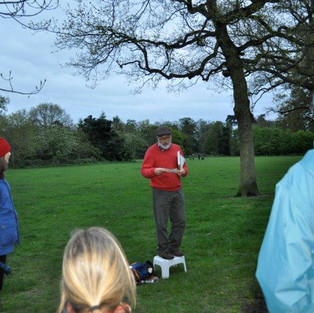Borders - An Exile Psychogeographer's Lockdown in Gloucestershire
- Walk Colchester

- Aug 1, 2021
- 3 min read
By Andrew Budd

For almost fifty years I lived within the protection of the Iron Age and Roman defences constructed on the Western Approach to Camulodunum. And now I’m living within the protection of our Cotswold Stone garden walls, on Covid-19 lockdown in our new home in Gloucestershire.
My plan for Walk Colchester’s ‘Jane’s Walk 2020' celebrations was to lead an event similar to one I ran a few years ago. This was entitled “Did Dinosaurs Once Roam the Streets of Prettygate?”, but the 2020 event was planned to be from the perspective of a long-term Colcestrian who now lives in exile. Hence the working title in the 2020 programme “Borders and Exile”.
When I first got involved in ‘Walk Colchester’ and ‘Jane’s Walks’ events, one of the aspects that greatly appealed to me was the possibly of celebrating our alternative histories. Not just the historic events associated with the Romans and the Tudors and the Siege. The commemoration of the ordinary.
For 2020 my walk was planned to for us to sample the Iron Age and Roman dykes in South West Colchester, looking at the theme of Borders and Barriers, and the sense of place, not just in ancient times, but also in subsequent times through to our Post-Brexit Britain.
I arrived in Colchester in September 1966, for half a term as a boarder at Colchester Royal Grammar School. I slept in the school’s Boarding House, in Beverley Road, above the graves of retired Roman soldiers. My eleven-years old imagination was convinced that the temperature dropped a degree or two when I walked through the hidden burial ground.
My parents moved to Colchester around Christmas 1966 so I left the boarding house. We now lived at Bergholt Road Post Office. From here I explored the Moat Farm dyke, and marvelled at the work involved in hand digging the twelve miles of dykes constructed to protect the pre-Roman Oppidum and also the later Roman City.
Living in north Colchester, I was aware that there was no certain route for part of the Roman Road that came out of the Roman City’s North Gate and crossed the River by bridge or ford nearby, possibly at Sheepen. A bit of map work allowed the schoolboy me to convince myself that, in fact, the Roman Road north to Ixworth went through our backgarden. Looking at the topography, I worked out exactly where the road would have been built, and set about making my own excavation to reveal the ancient surface. I kept quiet about this, as I knew it was wrong to excavate and thereby ruin historic remains. I dug a trench about a yard long and two feet wide. Expecting to find a gravelled road surface a foot down, I was disappointed to find nothing, even at double that depth. Not even a Victorian penny. I didn’t bother to report my lack of finding the imaginary road to the local Archaeology Trust.
From the Post Office my parents moved to Lexden. And I was safely tucked in between the Iron Age Lexden Dyke near Endsleigh school, and the Iron Age and Roman built Triple Dyke at Lexden Straight Road. Possibly, I lived in the heart of Claudius’s temporary camp occupied by the 30,000 strong Roman Army that invaded Britain in AD 43.
Through my work I had new insights into buried Colchester. I worked in Main Drainage and was responsible for miles of slit trenches up to twenty feet deep along the streets and countryside of south west Colchester. I kept an eye out for archaeology, especially where old earthworks were crossed by the new drains. Not surprisingly, no actual objects were found, or certainly none that the labourers admitted to me!
One final move, and it’s to Prettygate. This time I’m nestled between the ancient Heath Farm and Kidmans Dykes and the later Prettygate and Triple Dyke. A hundred years of digging activity, around two thousand years ago.
I never imagined these dykes were to be found under my Prettygate garden lawn, as the lines of the dykes could be accurately plotted in between the extant remains. But I did speculate that the ghosts of the Trinovantes, Catuvellauni and Romans would meet up for a social drink around a bonfire for Vulcanalia, one hot August night.
And in 2015 my Colchester years drew towards an end. My father died, and I no longer had the tie of being his carer. We fancied a move away; a new landscape to explore. Something green and hilly. We chose Gloucestershire, and we moved in April 2016, five months short of the anniversary of my move to Colchester fifty years earlier.
But the town and its people, and the western dykes system, are etched permanently in my psyche. Let’s share our stories in 2021.
Andrew Budd/ Fred Slattern
Photos from Andrew/Fred's original Jane's Walk: 'Did Dinosaurs Once Roam the Streets of Prettygate?' (2012)




















































Comments